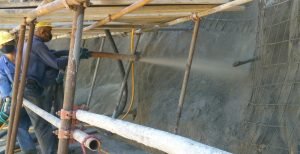Shotcrete is a well-known construction technique that stabilized more than 100 years ago. Same as concrete, testing shotcrete is crucial for quality construction.

Shotcrete requires specialized equipment such as a shotcrete gun, air compressor, concrete pump, and skilled nozzleman for placing. Shotcreting is more of a concreting process which applied pneumatically and compacted dynamically under high velocity.
Even though the method invented for quick repair works, now the technique is widely using for many constructions. You can see shotcrete is using for many structural and ground stabilizing jobs in the industry. Some of the standard applications of shotcrete are embankment stabilization, temporary and permanent tunnel lining works, pool and dome constructions, basement constructions and repairs.
Read the full article about the possibilities of shotcrete and involving steps during construction.
You can see many tests apply to both constructions. That is because similar concepts using in the concrete testing are used in the testing shotcrete too. Doing these tests at the right time is significant to identify weaknesses and improve the process.
All the test you do for shotcrete can categorize into 3 groups
| Pre-construction | During construction | Post-construction | |
| Material testing | Slump ASTM C143 | Immediately after construction | Few days after construction |
| Machinery testing | Air content ASTM C231, C173 | Penetrometer test ASTM C 803 | Core strength testing ASTM C1604 |
| Performing test panels | Temperature ASTM C1064 | Stud driving method (HILTI) | Flexural strength of fiber-reinforced shotcrete ASTM C1609 |
| Rebound measurement | Density ASTM C138 | End beam tester | Round determinate panel test ASTM C1550 |
| Bleeding ASTM C232 | Petrographic investigation ASTM C295 | Pull out test ASTM C900 | |
| Bond strength – pull off method ASTM C1583 | |||
| Permeability ASTM C642 | |||
| Drying shrinkage ASTM C157 |

Material testing
All the materials should test for their properties. Typically cement, water, and admixtures satisfy the requirements. However, coarse and fine aggregate content may be weak in quality. Check all the features and particle size distribution well before the selection.
Check machinery
Most significant factors to watch in any pieces of machinery are,
- Capacity
- Reliability
- Performance
- Timely maintenance record
Make sure all the factors are satisfied before the shotcrete placement. Arrange some repair kits for frequent breakdowns such as blockages.
Test panels
It’s essential to know how the original mix is behaving after mixing. Doing test panels will allow you to understand the mix and check the machinery. This is an excellent opportunity to test the nozzleman if possible.


Test during constructions
Slump test
This is the most common test on the fresh mix. It express the workability of the shotcrete mix. A slump range between 50 mm to 80 mm is generally use for the common works. The frequency for the test typically depending on the scale of the project.
Placing temperature
Mix temperature and the environmental temperature has a significant effect on the hydration. Read the article to know the possible consequences of cold weather on the cement hydration. Too hot and too cold mixes perform well under the satisfactory limit. 90 F – 40 F is the preferred temperature range for the mix. A needle thermometer is the easiest to use for this purpose.
Air content & density
Typical air content maintenance in the mix is generally 2%. You may lose original air content during pumping and spraying activities. Keep in mind that shotcrete is made using weights of the materials but sold by volumes!
Bleeding
Shotcrete is also subjected to bleeding as you encounter in concrete. However, due to thin layer placements and considerable exposure to the environment will quickly evaporate the collecting water. Do a standard bleeding test on the wet mix and calculate the ratio.
Post-construction tests
There are 2 groups of post-construction tests available for shotcrete.
- Tests immediately after the placement
- Tests after a few days
It’s essential to test the parameters like strength after a few hours of placing in order to use the site for other activities. This is crucial in tunnel excavations. When the excavation is over, shotcrete can be applied as the temporary support preventing sudden rock falls. In order to start the drilling for the next phase of blasting, the safe entry time should be calculated. Estimating real-time strength is vital to assure the safety of workers and improve the progress of the construction.
At first, within one hour of placement, the accelerated mix will reach to 1MPa strength. This is the first phase of strength development in shotcrete. After 2 to 3 hours, then the second phase will start and cover up to the target 28 days strength.
If the accelerator is missing in the mix, then the first phase is not visible in strength development. There are few tests for testing shotcrete strength.
| Initial strength | Penetration test ASTM C803 | 6, 20, 40, 60, 120 time intervals |
| Early strength | Stud driving method | Use for strength testing 3 to 8 hours |
| Flex beam tester ASTM C 1609 | ||
| Final strength | Core strength ASTM C 1604 | 28 days strength |
| RDP ASTM C1550 |
Conclusion
Similar to the concrete placement, shotcrete should also monitor with various tests. The tests will be useful for validating the mix and procedure as well as the strength gain.
Common tests discussed above can identify the shortcomings and indicate the requirement for improvements. Always, testing at the right time will save you money and time.

